Are you looking for a delightful and savory way to elevate your meals? Look no further than our Homemade Au Jus Recipe! With our easy-to-follow recipe, you can create this mouthwatering sauce right in the comfort of your kitchen. So, get ready to impress your family and friends with our delicious recipe that will take your meals to a new level of culinary excellence.
Introduction to Au Jus Recipe

Au Jus, which translates to “with juice” in French, is a versatile sauce that can be made in just 5 minutes. Whether you’re making French Dip sandwiches or want to add moisture to reheated meats, having a reliable Au Jus recipe in your culinary arsenal is a game-changer.
The beauty of Au Jus lies in its simplicity. It combines drippings (or butter), beef juices (or broth/stock), Worcestershire sauce, and red wine in a saucepan over high heat. This mixture is then brought to a boil, allowing the flavors to meld together and create a delectable sauce.
Not only does homemade Au Jus add depth of flavor to your dishes, but it also helps to keep meats moist when reheating them. This makes it a fantastic tool in your kitchen for ensuring that your meals stay succulent and flavorful.
Popular Variations of Au Jus Recipes

Classic Beef Au Jus Recipe
The classic beef au jus recipe is the most common and traditional version. It combines beef broth, Worcestershire sauce, butter, and sometimes beef drippings. This rich and savory sauce is perfect for enhancing the flavor of prime rib, roast beef, and French dip sandwiches.
Pork Au Jus Variations
While beef is the most commonly used meat for au jus, pork can also create delicious variations. Pork au jus recipes often utilize pork or stock instead of beef broth. Adding herbs and spices such as thyme, rosemary, and garlic can further enhance the flavor profile, making it a great accompaniment for pork chops or roasted pork tenderloin.
Chicken Au Jus Recipes
Chicken au jus recipes are a lighter alternative to the beef and pork versions. Using chicken broth as the base, this variation offers a milder flavor profile. It pairs well with roasted or grilled chicken, adding a touch of richness without overpowering the delicate taste of the meat. Herbs like sage, parsley, and a splash of lemon juice can be added to elevate the taste.
Vegetarian Alternatives to Au Jus
For those following a vegetarian diet or looking for meatless options, there are alternatives to au jus that offer similar flavors.
- One option is to use vegetable broth or mushroom broth as the base. Adding soy sauce and Worcestershire sauce can replicate the umami taste in meat-based au jus.
- Another option is to create a flavorful vegetable-based gravy using ingredients like onions, garlic, herbs, and vegetable stock.
Read more:
Tips and Tricks for Perfect Au Jus

I am correctly deglazing the roasting pan for maximum flavor extraction.
When making au jus, it is essential to deglaze the roasting pan to extract maximum flavor properly. Deglazing involves using a liquid, such as wine or stock, to dissolve the flavorful bits of food stuck to the pan during cooking, known as ‘fond.’ You capture and reintegrate these intense flavors into the au jus by deglazing the pan, resulting in a rich and savory sauce.
Adjusting the consistency by reducing or thinning as desired
One of the great aspects of making homemade au jus is adjusting its consistency according to personal preference. If you want a thicker sauce, you can reduce the au jus by simmering it longer to evaporate excess liquid. On the other hand, if you prefer a thinner sauce, you can thin it by adding a bit of stock or broth.
Storing and reheating leftovers for future use
If you have leftover au jus, it’s important to store it properly to maintain its flavor and quality. Allow the sauce to cool down before transferring it to an airtight container. You can refrigerate it for a few days or freeze it for longer storage. When reheating, gently warm the sauce on the stovetop or in the microwave, being careful not to overheat it and lose the flavor.
Proper Deglazing Techniques
To ensure successful deglazing, there are a few techniques you should follow. First, preheat your roasting pan before cooking to promote fond formation. Once the meat is cooked, please remove it from the pan and set it aside. Next, pour a liquid like wine, stock, or vinegar into the hot pan and use a wooden spoon or a whisk to scrape the fond from the bottom. This will dissolve the flavorful bits and incorporate them into the au jus. Finally, strain the liquid to remove any solids and achieve a smooth sauce.
Au Jus Recipe

Ingredients
- Drippings and fat from roast beef or prime rib
- 1 rounded tablespoon all-purpose flour
- 2 cups cold beef broth or beef stock
- Salt, to taste
Instructions
- Pour off most of the fat from the roast beef or prime rib drippings, leaving about a quarter cup of fat along with the meat juices.
- Place the roasting pan with the drippings over medium-high heat.
- Sprinkle in the flour, whisking constantly to remove any caramelized bits from the bottom of the pan. This is known as the "fond."
- Cook the flour in the fat for about 3 minutes until it turns a light brown color.
- Drizzle in the cold beef broth or stock, stirring well to combine with the flour and fat mixture.
- Increase the heat to high and bring the mixture to a boil.
- Once it boils, it is ready to serve. If desired, reduce the au jus for about 5 minutes to thicken it slightly.
- Taste the au jus and add salt if needed, depending on the seasoning of the beef.
Serve the au jus alongside the roast beef or prime rib, ensuring it stays hot.
Notes
It is not necessary to skim off the fat from the top of the au jus. It adds flavor and helps keep the meat warm. Avoid adding herbs, garlic, or hot peppers to maintain this Au Jus recipe's traditional and simple flavor.

Hey readers! Chip Holland here, and I’m a Manager of this website. My passion for writing about it only matches my passion for BBQ. Follow my blog for mouth-watering recipes, tips, and tricks for the perfect smoke, grill, and BBQ. I’m sure you won’t be disappointed!
